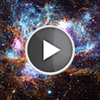CXC Home | Search | Help | Image Use Policy | Latest Images | Privacy | Accessibility | Glossary | Q&A
Tour of NGC 6357
Quicktime MPEG With closed-captions (at YouTube)
Although there are no seasons in space, this cosmic vista invokes thoughts of a frosty winter landscape. It is, in fact, a region called NGC 6357 where radiation from hot, young stars is energizing the cooler gas in the cloud that surrounds them.
Located about 5,500 light years from Earth, NGC 6357 is actually a "cluster of clusters" containing at least three clusters of young stars, including many hot, massive, luminous stars. X-ray data from Chandra and ROSAT reveal hundreds of point sources, which are the young stars in NGC 6357, as well as diffuse X-ray emission from hot gas. There are bubbles, or cavities, that have been created by radiation and material blowing away from the surfaces of massive stars, plus supernova explosions.
Researchers use Chandra to study NGC 6357 and similar objects because young stars are bright in X-rays. Also, X-rays can penetrate the shrouds of gas and dust surrounding these infant stars, allowing astronomers to see details of star birth that would be otherwise missed.
[Runtime: 02:08]
Quicktime MPEG With closed-captions (at YouTube)
Although there are no seasons in space, this cosmic vista invokes thoughts of a frosty winter landscape. It is, in fact, a region called NGC 6357 where radiation from hot, young stars is energizing the cooler gas in the cloud that surrounds them.
Located about 5,500 light years from Earth, NGC 6357 is actually a "cluster of clusters" containing at least three clusters of young stars, including many hot, massive, luminous stars. X-ray data from Chandra and ROSAT reveal hundreds of point sources, which are the young stars in NGC 6357, as well as diffuse X-ray emission from hot gas. There are bubbles, or cavities, that have been created by radiation and material blowing away from the surfaces of massive stars, plus supernova explosions.
Researchers use Chandra to study NGC 6357 and similar objects because young stars are bright in X-rays. Also, X-rays can penetrate the shrouds of gas and dust surrounding these infant stars, allowing astronomers to see details of star birth that would be otherwise missed.
[Runtime: 02:08]
(Credit: X-ray: NASA/CXC/PSU/L.Townsley et al; Optical: UKIRT; Infrared: NASA/JPL-Caltech)
Return to NGC 6357 (December 19, 2016)



